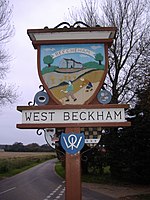North Barningham

North Barningham is a hamlet within the civil parish of Gresham in the English county of Norfolk. The hamlet is 7 miles (11 km) south-west of Cromer, 23.2 miles (37.3 km) north-northwest of Norwich and 138 miles (222 km) north-northeast of London. The hamlet lies 4.6 miles (7.4 km) south of the town of Sheringham. The nearest railway station is at Sheringham for the Bittern Line which runs between Sheringham, Cromer and Norwich. The nearest airport is Norwich International Airport. The hamlet is within the parish of Gresham, which had, in the 2001 census, a population of 443. For the purposes of local government, the hamlet falls within the district of North Norfolk.
Excerpt from the Wikipedia article North Barningham (License: CC BY-SA 3.0, Authors, Images).North Barningham
Green Lane, North Norfolk Matlask
Geographical coordinates (GPS) Address Nearby Places Show on map
Geographical coordinates (GPS)
| Latitude | Longitude |
|---|---|
| N 52.88825 ° | E 1.18998 ° |
Address
Green Lane
Green Lane
NR11 7LA North Norfolk, Matlask
England, United Kingdom
Open on Google Maps










